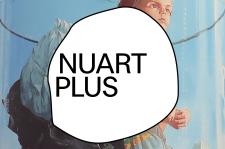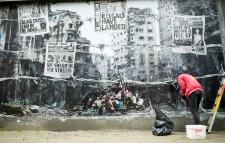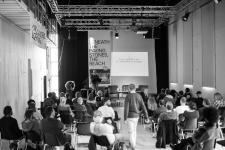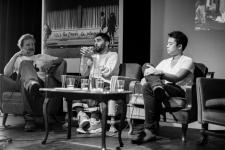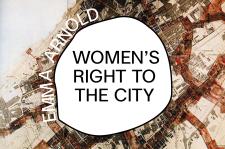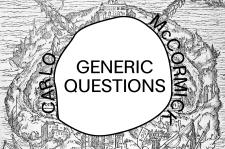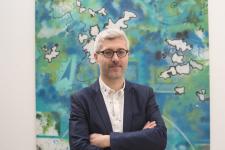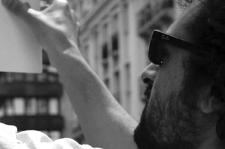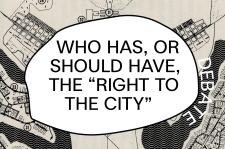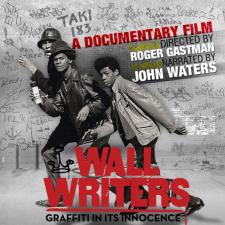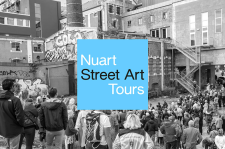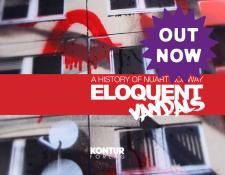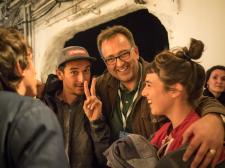
GENERIC QUESTIONS
By Carlo McCormick
This year Nuart celebrates the hundredth anniversary of Cabaret Voltaire and the founding of Dada. Simply put we might say that never before had a group of artists faced so directly the absurdity of life, and perhaps not since then have artists been able to fully ignore these complete absurdities. As you put your public art out into this world now, how do you address the cruel
and hilarious absurdities of life?
ADD FUEL
I tend to look at life as a chain of absurdities and odd events interlaced with some less weird things happening in the middle. My works has this inherent double meaning (and double vision) effect of looking into traditional elements, almost forgotten themes, and make them somehow new and contemporary. So in my art I use this way of thinking to add some semi-humorous elements, inserted in a serious and contemplative concept.
FINTAN MAGEE
I guess cruelty and absurdity in life is really just based on your individual view point. I just try to document and be inspired by what’s around me.
EVOL
Well, you're right, there's so much shit going on that it's hard for any person to deal with. We should remind ourselves of the cruel ones. All though I personally don't want friends who's telling me what to think, and I don't tell my friends what to think either. When I was younger I felt my art should consist of all my critiques, until I found out that things can just be good. And for the good. Anyway, I prefer to give hints and make the spectators make up their mind about it themselves. A thought that is not made by one himself is not very fertile anyway. And don't forget to celebrate all the hilarious absurdities of life, there's so much vitamins for the brain in those…
JEFF GILLETTE
Loveable contemporary icons (Disney, etc.) are placed in my work to juxtapose dystopian landscapes of ‘worst case scenarios:’ Post Nuclear Holocaust, Filthy Landfills and Third-World Slums. A pessimist by nature, this is my own way to cull some humor out of a potentially depressing, hopelessly tragic world future we are facing now.
KENNARDPHILLIPPS
100 years ago dada responded to the horrors of the first world war with a cry of anarchy and mash-up. Respectable society was duly outraged. Today their work doesn’t outrage, it sells for millions. Looking back, Dada appears as a logical response to a war in which millions died for a few acres of mud. In a sense the shards of their work scattered through performance, publication, poems and collage was social realism about the politics of massacre that many of them had experienced first-hand. The work and actions of the Dadaists reverberates now. Artworkers today are working in global laboratories rather than studios. Researching and developing strategies and tactics that can rip through the corporation of images that bombards us at every turn, every screen, every street, searching for forms that refuse our current political/social/economic massacres.
NIPPER
Wow! This is the first question! How about a dark room and a lamp? The cruel and hilarious absurdities of life? Hasn't it always been this way? I, like Knut, walk down to the beach and raise my hand out towards the on rushing tide and say to the sea "Stop! Do not come in!". I do not know that we can ever effect the moon. All we can do is be prepared to stand in our folly. Or, it could be, we are directing our request to the wrong body?
Nuart is also marking the five hundred years since the publication of Thomas More’s Utopia, from which we inherit this wonderfully impossible ideal of utopia. How do we continue to believe in a utopian paradigm of hope and progress and express it now in this dystopian present?
ADD FUEL
I believe it's all about doing what you love and really trying
not to think much about anything else. I can elaborate on that. So, by doing what you believe is right, by putting your heart in your work/art you are being honest and sincere. This is the way I try to stay positive and true in an ever so distorted world. Utopia as a reality is impossible, but a common ground being a "state of prosperity" is not so crazy to believe in. This I think can be achieved if we as human beings feel fulfilled as persons in our daily lives. How do you do that? Do what you love.
Fintan magee
I have never really believed in a utopian paradigm, I think
the world is what it is and I am certainly not an idealist or
a pessimist. I think the best we can hope for is survival and relative happiness. Right now we are moderately successful
at both.
EVOL
This ongoing "Plattenbauten" project of mine (the miniature prefab housing blocks) was initiated out of the same discrepancy between demand and reality. Though I can't really say how much of an influence Thomas Morus' book was for the Socialist idea to create a perfect and equal world, I mean these dreams of an ideal society has existed since the old Greek. Architecture is anyway a big inspiration for me, being not only a good metaphor and clear indicator for the state of a society, but also defining our living space and even providing us with the surfaces to work on. I found these iconic socialist prefab buildings being a perfect symbol for this failed utopia, which has cynically turned into symbols for a non-functioning class society. The idea behind this was to install small reminders of their bigger brothers from the outskirts back into the beautificated commercialized centers and to keep these symbols of a failed utopia and class society present in the collective memory of the city. How do we continue? Spread the love and you will feel the hope inside. Mind the past and learn from it. And maybe we should finally overcome this motherfucking greed!
JEFF GILLETTE
When I was in Nepal for two years with a lot of time on my hands for reading, I discovered the German Philosopher Arthur Schopenhauer (a predecessor to Nietzsche). His Metaphysical/Buddhist/Nihilistic outlook is that life is pretty much a mistake: endlessly mired in pointless agony, fear, hunger, destruction and lust. All that exists is this brief, ever-present, personal dystopia we are trapped in and the infinite void that lies beyond. One of the only respites from this turmoil is to immerse oneself in Aesthetic Experience. Contemplation of Nature and Art can become one’s Savior either by losing oneself in it or even better, working on becoming what Schopenhauer calls ‘the creative genius.’ I feel fortunate that visual art has become my obsession, my psychic umbrella shielding me from a potentially terrifying world slipping into inevitable doom. Pass me the Cobalt Blue please…
KENNARDPHILLIPPS
Brecht said that in his writing he didn’t want to start from the good old days but the bad new ones. The most pungent visions of utopia today are those that are soaked through and through with the bad new days. It is through confronting what’s here NOW that activist art throws a moving beam of light on what corporate imagery shows as stable and inexorable. What’s utopian in our time is to rip through an advert that offers utopia in a diamond ring and under the rip reveals who is mining the diamonds, where they are, how they live. It is utopian to show we are not blind to our position in the chain of demand and that we can get together and demand to break that chain.
NIPPER
Our narratives are way too complex and never so clean as to be able to describe the present moment as simply dystopian. Undoubtedly there are tremendous issues on all sides. Yet! I can point to things in which we can be hopeful. I find wonder in others more than I do not. For me, Utopia is not a static destination. It's momentary. To be constantly created over and again and found. The 'real world' that we know as society and culture is a fiction to which we give substance. We sleep to awaken to the world that is to come. Why? Because we are creative. We are allowed to reform and create over and remould! What is beautiful is the legitimate diversity of each one, and of our creative collective possibilities. It is this diversity of possibility in how we can meet and envisage that remains a hope. We live in the specter of hope and if it will ever come. Perhaps hope arrives everyday, but it does not take the form we expect of it? Perhaps we need to stop to take time to look again and to reconsider? What is difficult is the everyday. It is like we sit upon a train that shuttles us from A.M. Station to Night Station and back. Along the ride maybe we glimpse out of the window as it all blurs by. Making and placingart into the world is the incursion onto the passive tracks that speed through the wild. From civilisation to civilisation, Amen. It is a form of charge to derail the network of our inertia. In a sense the art enables us to step off and walk into the wild. We run with the wild things. It is the feel of grass barefoot.
There is much talk now that we have already come to the fruition of this first wave of Street Art’s possibilities and are now on to something else, something post-street art that extends this language of intervention in different directions. Culture is predicated on an act of creation, but this creativity is based off a contrary impulse of destruction. Art gives life to new ideas and ways of seeing but it does so in a murderous fury that more often seeks to kill, which is probably why every other generation comes to make declarations like ‘painting is dead.’ Do you feel we are at some sort of end for what is traditionally thought of as street art, and if so in what direction are you trying to go beyond this simple definition?
ADD FUEL
I don't really think that painting is dead. I believe that there is much more that can (and is) being achieved nowadays in terms of urban interaction. From sculpture to installation (digital and analog) there is a lot of ground still to explore. Personally I love to paint, but I'm always aiming to have my work as a ceramic panel whenever possible (whether it be for events or private commissions). But I don't want to only be doing one thing, so I’m constantly trying to come up with new ideas. Street art is such a broad concept nowadays that it extends beyond muralism. Urban art, public art, public interventions, performances, all of these concepts are being debated and evolving organically. I guess what I'm trying to say is that for me personally it’s very difficult to predict what's to come.
FINTAN MAGEE
I think we are coming close to an end yes, or at least a transition period. Art is constantly recycling itself but predicting its direction is very difficult. I see it headed in a similar direction as Modernism which would see less focus on traditional methods such as painting and more focus on installation work and new media. The DIY element in street art makes it difficult to imagine how this will work though. I guess we just have to wait and see.
EVOL
Whoever puts art in a public space meant to communicate with the public, both traditionally installed/commissioned works as well as for illegally installed works. They may differ on the 'targeted audience' of course, but art is a reflection and contribution to the state of things and society because it can never 'die'. Only certain ideas, forms or topics can run dry when they just don't talk to anyone anymore. And if everything is covered in colorful murals, regardless of how good they might be, it will just become the same pink noise as advertisement and your eyes and mind will start gasping for some blank space. Thinking of any kind of art in a primarily visual way may have run a little dry, but there's so many more ways to intervene, even without the possibilities that come with modern technologies /as a tool or a playground, there is a lot of psychological ways to influence, interact or question the routines or pattern of behavior or perception.
JEFF GILLETTE
Street Art to me is an aesthetic awareness gifted to people who would not ordinarily experience artistic talent and creative expression directly. Everywhere there are bare, old walls that would do well to have something interesting put on them. Here in Southern California, we have hundreds of miles of freeways bounded by high, ugly walls. We, as in the government, should provide scaffolding, paint and stipends to budding artists and let them beautify the cityscape in designated areas. It would be a lot cheaper and much more productive than the anti-graffiti and at-risk youth programs we pour money into now.
KENNARDPHILLIPPS
Street art began as cave art. The most direct stenciling on walls was created hundreds of thousands of years ago in caves when they placed their hand on a cave wall and put color all round their fingers, leaving a negative image of their hand. They are still there. There ain’t nothing new. In the Middle Eastern revolutions they risked their lives to paint images of events as they unfolded and they still do. There are no designated graffiti areas funded with public money in most countries. The artworkers are risking their necks to say through images what’s been banned. All over the world street art is deeply significant, it is a means (maybe the only means) for the increasingly silenced to speak in public to the increasingly silenced.
NIPPER
An aspect in street art that has been important, to me, has been its move away from the symbols enshrined in the gallery and the unwrapping of those powerful gods. It has been a move into our everyday and places us into the everyday. I find there is a value in street art when I make it only as "GIFT"! It's more iconoclastic this way. I simple make my little bits and pieces. Making street art has been a breaking with existing structures and this task I don't see as completed, yet, perhaps the first wave is over. This is not something I really think about. I just walk. Often through the smoke and hold to a fragile fidelity, to an idea that the object of art can be a vehicle which we experience as having a potency to bring us to a sense of our own radical subjectivity. A work on the street can cause us to step out for a moment and see, but the progression can only continue through how we actively move on from that point and allow shared space to trigger our creativity. So, when we see the world around us, it begins to resonate with us. The next 'move' might not be what we find in the streets, but how we collectively come to see the street? In post-street we will all become bad timekeepers, but better storytellers, because on our journeys we will be looking to play creatively with the surroundings, allowing our eyes to rest on that which resonates within: we find triggers, causing us to traverse the fantasy of our imagination, evoking its images, words and sounds. And a friend's late arrival will be a prelude to a story to come.
Not so long ago Nuart was one of but a few organized curatorial showcases for the DIY sensibilities of a then emergent public art form. Today there are too many festivals of this sort to count, all over the world at almost any time of the year. How has this proliferation of opportunity and exposure changed your work and the intimacy of the scene in which it was born? Is it all good, or are we nearing a point where it is just too much?
ADD FUEL
When I started to participate more and more in organized events, I felt that my work shifted in some directions I was not expecting. This happened due to the locations of the intervention. I try to adapt my work to the country I'm in, work with that countries tradition and culture. So traveling allowed me to explore my work in ways that most of the times I never even thought possible. It was not a negative thing for me, at all. So, the fact that there are so many opportunities right now for artists to showcase their work is of course very interesting and can be very prolific for an artist's career. Personally I feel that the possible downside of this is that sometimes the entities behind the organization of these events look more towards quantity of artists/artworks, rather than quality, or on another point of view, they tend to go for the "safe choices", meaning, always the same artists in a lot of these events.
FINTAN MAGEE
I think we are in the middle of the peak right now. It’s crazy how many festivals are happening. I think it has to slow down soon. I think there is still plenty of possibilities to keep festivals fresh, I would just love to see some variations in the content of festivals. It would be great to see more sculptures and installations etc. Everything seems very mural focused right now. I guess with the budget restraints many festivals having sculpture and other mediums are difficult.
EVOL
Honestly, it seems there's a demand for it. So, on one hand I can't see anything negative in people from all over the world organizing these events and making people that would never met, work together. The exchange and sharing is a good thing I think. And on the other hand, you wouldn't have to participate if you don't want to either. In my case, ideally a good work rather starts with a specific place you found and not with an invitation to a festival as such. So I'm not doing these very often.
JEFF GILLETTE
There can never be too much art or too much exposure to art. Art Festivals like NUART provide for a venue to create and appreciate art outside of the gallery or museum. Since these events are spearheaded by like-minded individuals with artistic ideals, the art is consistently of high caliber. Every city should have a festival like this at some time!
KENNARDPHILLIPPS
It’s not possible to have too many images in our cities made by street artworkers. Public space is being eaten up by corporations and spat out as billboards of every shape, size and medium. Increasingly digital adverts suck our eyes into a pixelated void. Whether it’s painted illegally by the cover of night or legally in a festival of street art it is vital that street artworkers proliferate, congregate and agitate. They are the counter–voice to the money men who are taking over our cities and turning them into advertisements for themselves.
NIPPER
Festivals are not that interesting to me. They're not everyday life. Although, they have a role because they give us spaces in which we can celebrate. That festivals have exploded is a mark of how people have come to regard this form of this public art. Let people play. Let them have fun. Can there ever be too much art? For too long everyday life has been devoid of it. The party has only just kicked off. Let's get drunk! And when we wake up from it all with a headache, I'm sure we can find someone left with a bucket of grey paint and a roller. Festivals are not that interesting to me. They're not everyday life. Although, they have a role because they give us spaces in which we can celebrate. That festivals have exploded is a mark of how people have come to regard this form of this public art. Let people play. Let them have fun. Can there ever be too much art? For too long everyday life has been devoid of it. The party has only just kicked off. Let's get drunk! And when we wake up from it all with a headache, I'm sure we can find someone left with a bucket of grey paint and a roller.
FIGHT CLUB - MAKING HISTORY WITH 'POST-STREET ART'
Fight Club was established in 2012 as a way to introduce difficult topics in a more relaxed environment condusive to public engagement.
NUART PLUS 2016 PROGRAM
This year’s Nuart Plus symposium will explore the topics of ‘Utopia and Rights to the City’ and ‘Dada, Art and Everyday Life’ on the 500th anniversary of Thomas M...
NUART PLUS 2016 - DAY 1 - KENNARDPHILLIPPS Talk & Q&A Session
Utopia, from the artists perspective
Artist presentation by Kennardphillipps, followed by a Q&A session with Carlo McCormick.
NUART PLUS 2016 - DAY 1 - NUTOPIA
Nutopia panel debate
Discussion led by: David Pinder
Panel: Pedro Soares Neves, Peter Bengtsen, Emma Arnold
NUART PLUS 2016 - DAY 2 - JEFF GILLETTE AND HENRIK ULDALEN
Panel debate: The Borders of Street Art
Artists presentations by Jeff Gillette and Henrik Uldalen, followed by a Q&A session with Evan Pricco
WOMEN’S RIGHT TO THE CITY
By Emma Arnold
SUBVERTING AND CONTESTING THE MASCULINE AND SEXUALISED CITY
CARLO McCORMICK (US)
Pop culture critic, curator, and Senior Editor of PAPER magazine
EMMA ARNOLD (CA)
Research Fellow, University of Oslo Department of Sociology and Human Geography
PEDRO SOARES-NEVES (PT)
Founder, Lisbon Street Art and Urban Creativity
PETER BENGTSEN (SE)
Art historian and sociologist, Department of Arts and Cultural Sciences, Lund University
DEBATE: WHO HAS, OR SHOULD HAVE, THE "RIGHT TO THE CITY"
Henri Lefebvre’s "right to the city" concept provokes us to consider how we might remake the city with the goal of creating more just and ideal societies.
WALL WRITERS FILM SCREENNG
Nuart Festival and SF Kino Stavanger present Wall Writers: Graffiti in its Innocence



